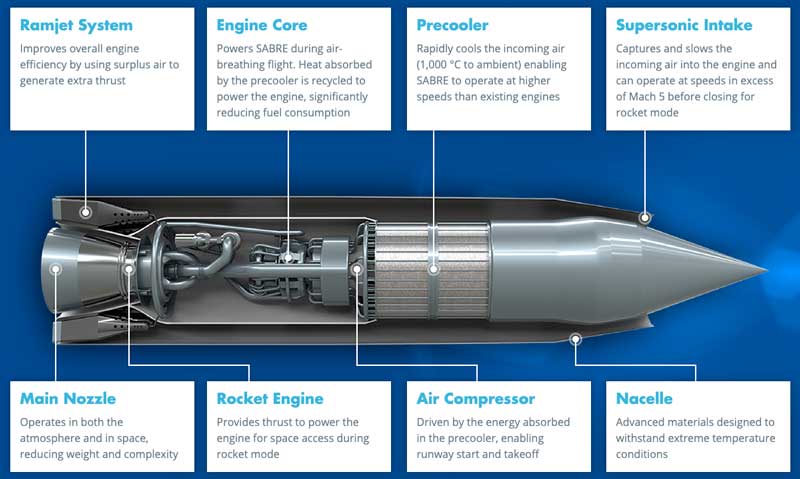A Look into Reaction Engines & The SABRE Engine
Reaction Engines is a United Kingdom based company, with its headquarters based in Oxfordshire. Compared to the big players in the space tourism industry, like SpaceX, Blue Origin and Virgin Galactic, this company is not well known to the wider public. For industry insiders though, this company’s futuristic hybrid jet / rocket engine is definitely one to watch. Its design is innovative, even revolutionary, and it is quite unlike any of its rivals.
It is frequently the case that ideas and designs which seem outlandish are often just that: they look great on paper but end up firmly on the sci-fi pages. Ideas like fusion reactors and space elevators are theoretically possible, but seem to have been described as ‘just round the corner’ since the 1950s. But Reaction Engines’ rocket design has already been tested. Prototypes and scaled models have already been produced, so their own engine seems to be very much more practical and closer to actual production.
Nevertheless, the United Kingdom has little history of being a market leader in rocket technology in recent years. It made attempts in the period immediately following World War Two to keep up with the United States and Soviet Union’s rocket development. These were fuelled by the Cold War arms race though, and the war weary, ration restricted UK economy could not keep up. The 1950s saw the UK government make increasingly futile attempts to develop rival projects, but its own rocket industry was largely mothballed with the cancellation of the Blue Streak project in 1960.
In recent years however, commercial companies have been the force behind great developments in space technology in the UK, with the British Aerospace facility in Hertfordshire becoming a world leading constructor of satellite technology. Other smaller companies have also been making waves in the industry, often with UK government’s support, and contracts from the European Space Agency (ESA).
Reaction Engines is part of this burgeoning aerospace development, putting the UK back on the map within the global space technology industry.

History and Development of Reaction Engines
Reaction Engines was founded in 1989 by Alan Bond, a leading British aerospace engineer, together with two ex-Rolls Royce engineers: Richard Varvill and John Scott-Scott. Their initial focus was on the HOTOL (Horizontal Take Off and Landing) spaceplane project. The company was a member of the consortium responsible for the design of this futuristic spaceplane, along with British Aerospace and Rolls Royce.
However, UK government involvement in the project meant that much of the detail behind the design had to be kept secret. This meant that it was difficult to obtain additional investment, or to find potential partners and customers for the intended spaceplane. This lack of outside investment, together with persistent technical problems led to Rolls Royce’s withdrawal from the project and the UK government then declined to provide further funding. The project ended in 1988.
Reaction Engines then decided to focus on its own design, using the technological expertise they had gained from the unsuccessful HOTOL plans. Its new spaceplane design is called Skylon. This will be powered by the company’s revolutionary hybrid air-breathing rocket SABRE engine.
SABRE is an acronym for Synergetic Air-Breathing Rocket Engine, and it uses a unique ultra-lightweight super cooler to stop engine components from overheating when travelling at supersonic speeds. The super cooler works by using heat exchangers to chill the air before it is fed into the engine.
The engine’s pre-cooler has already been manufactured and tested at speeds equivalent to over three times the speed of sound (Mach 3) at the company’s test facility in the state of Colorado in the United States. A further test facility is being constructed at Westcott in Buckinghamshire in the UK, not far from its Oxfordshire headquarters. This will be capable of testing the fully constructed core engine. Tests are expected to begin in 2020.
You can find out more details about this innovative rocket engine here [link to SABRE Rocket article] [hyperlink required].
The fact that the project is now entirely in private hands has removed the problem of government secrecy, and outside interest and investment has certainly been more forthcoming.
Ironically, the new strategy means that all of the original HOTOL consortium partners are now involved. British Aerospace (BAE) is a major outside investor. It took a 20% stake in the company in 2015, paying around £20m for their investment. Reaction Engines has also secured an agreement to provide an additional £60m in funding from ESA and the UK government’s Space Agency. Major aerospace companies like Rolls Royce and Boeing also provide backing.
What Does the Future Hold for Reaction Engines and SABRE
The future certainly looks bright for Reaction Engines. Testing on SABRE engine components has been successful so far, providing confidence that the technology works in the real world as well as in theory. The fact that other major aerospace manufacturers and major space agencies including NASA are investing in the company is a further demonstration of confidence.
The pre-cooling technology means that SABRE engines will be able to travel far faster than conventional jet engines, reaching a potential maximum speed of more than five times the speed of sound (Mach 5). This will enable SABRE powered aircraft to travel to any destination, anywhere on Earth in no more than five hours. London to Sydney in Australia, for example, would be expected to take around four and a half hours.
But SABRE engine powered aircraft will be capable of even more than this. Traditional jet engines need air to function, and therefore cannot leave the Earth’s atmosphere. SABRE engines are a jet / rocket hybrid, so any craft powered by these engines could be capable of spaceflight too.
Skylon, Reaction Engines’ prototype spaceplane will be capable of reaching Earth orbit by taking off on a conventional runway, then returning to Earth the same way. It will become the world’s first true spaceplane, with both take-off and landing being achieved horizontally and independently (Virgin’s proposed spaceplane also takes off horizontally, but only by piggy-backing on top of a larger delivery aircraft). Unlike conventional rockets, it will also be totally re-usable, just like a conventional airliner.
Skylon’s potential for space tourism is clear, and it is planned to be flying by 2025.
The company’s pre-cooler technology can be used for lots of other potential applications too. It could be particularly useful when used in combination with conventional jet engines. By pre-cooling the airflow, the operating temperature of engines can be kept more tightly controlled. This could be used to increase the operating life of engines, help them to run more efficiently and even increase the potential speed of the aircraft. New conventional jet engine designs may well include SABRE pre-cooling technology as a standard feature.
With testing going well thus far, and full engine trials expected to begin in 2020, the prospects for Reaction Engines’ revolutionary SABRE technology look good. Provided that these tests go as expected, the company’s hybrid engines will provide yet another option for potential space tourists. This provides two major positives: another engine (SABRE) and launch vehicle (Skylon) will increase passenger capacity within the space tourism industry and should enable more people to fly into space. Furthermore, another company and vehicle providing potential spaceflights will increase competition within the industry, which should drive down prices. The prospect of affordable trips into space for the masses is therefore coming ever closer.
Even if this possibility does seem some way off as yet, there remains the prospect of reaching speeds of Mach 5 even on a conventional aircraft. This will provide the capability for passengers to make a trip to the other side of the world in less than five hours. Soon, we will be able to travel to Australia or New Zealand in less than the time it takes to fly from London to New York today.
So Reaction Engines is a name to watch. It could be one of the major players in the burgeoning worldwide and space tourism industry in the years to come.
